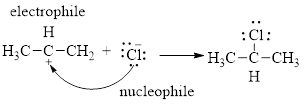
(a)
Interpretation:
For the given
Concept introduction:
Nucleophile: Nucleophiles are electron rich compounds which donates electrons to electrophilic compounds which results in bond formation.
Nucleophilic nature depends on the negative charge present in the molecule, the solvent in which it present and the electronegativity of the atom.
Electrophile: Electrophiles are electron deficient compounds which accepts electrons from nucleophiles that results in bond formation.
Chemical reaction involves bond making and breaking of two or more reactants in order to attain products from the reactants.
Curved arrows show the bonds that are formed and the bonds that are broken in a reaction.
Curved arrows used to understand a reaction mechanism.
Curved arrows are drawn to show how the electrons move as new covalent bonds are formed existing covalent bonds are broken.
(a)
Explanation of Solution

Analyzing the given reaction it shows that
The reactant
Therefore, the curved arrows indication the bond making and the breaking in order to obtain the given product is as follows,
(b)
Interpretation:
For the given chemical reaction the electrophile and the nucleophile should be determined and the curved arrows that denote the bond making and breaking should be indicated.
Concept introduction:
Nucleophile: Nucleophiles are electron rich compounds which donates electrons to electrophilic compounds which results in bond formation.
Nucleophilic nature depends on the negative charge present in the molecule, the solvent in which it present and the electronegativity of the atom.
Electrophile: Electrophiles are electron deficient compounds which accepts electrons from nucleophiles that results in bond formation.
Chemical reaction involves bond making and breaking of two or more reactants in order to attain products from the reactants.
Curved arrows show the bonds that are formed and the bonds that are broken in a reaction.
Curved arrows used to understand a reaction mechanism.
Curved arrows are drawn to show how the electrons move as new covalent bonds are formed existing covalent bonds are broken.
(b)
Explanation of Solution

Analyzing the given reaction it shows that
The reactant
Therefore, the curved arrows indication the bond making and the breaking in order to obtain the given product is as follows,
Want to see more full solutions like this?
Chapter 6 Solutions
EP ESSENTIAL ORG.CHEM.-MOD.MASTERING
- 12) Use the curved arrow formalism to show the movement of electron pairs in the following reaction and label each reactant as a nucleophile or an electrophile. CHÍNH CHỊCH, + CO Học Nha CH₂CH₂CIarrow_forwardWrite the ambident nucleophiles? Give an example.arrow_forwardFor the given Sy2 reaction, draw the organic and inorganic products of the reaction, and identify the nucleophile, substrate, and leaving group. Include wedge-and-dash bonds and draw hydrogen on a stereocenter. :CEN Organic product Inorganic product + Draw the organic product. Draw the inorganic product. Incorrectarrow_forward
- 1) The carbon-oxygen double bond present in aldehydes and ketones is very polar. What does this mean and how does it arise? 2) The carbon-oxygen double bond is readily attacked by nucleophiles like cyanide ions or ammonia. (i) What do you understand by the term nucleophile? (ii) Which part of the carbon-oxygen double bond is attractive to nucleophiles? 3) Why is there a difference between aldehydes and ketones in their response to oxidizing agents such as potassium dichromate(VI) solution acidified with dilute sulfuric acid?arrow_forwardLabel the nucleophile and electrophile. For the electrophiles mark the place for nucleophilic attack.arrow_forward46. The Strength of Nucleophile: Which one is the strongest nucleophile? OH (B) 0-CH, -CH, (D) O (C) O (A) O (D) O (B)arrow_forward
- Consider the following nucleophilic substitution reaction. The compound listed above the arrow is the solvent for the reaction. If nothing is listed over the arrow, then the nucleophile is also the solvent for the reaction. I acetone + HSarrow_forwardHeterolysis of the C–Z bond can generate a carbocation or a carbanion. Explain How ?arrow_forwardCompare the following pairs of molecules and determine which one is the stronger nucleophilearrow_forward
- Hydroxide acts as a nucleophile in protein degradation by hydrolysis of the peptide bond in water. Draw out an arrow pushing mechanism of the hydrolysis of a peptide bond. Identify the nucleophile and the electrophile in this reaction.arrow_forwardwhat will be the type of interaction of ethane with bromine: a) radicals b) ionic c) nucleophilic d) electrophilicarrow_forwardcreate a synthesis reaction for N,N-dimethylethanamide from alkene, alkane, a halogen, and ammonia. Draw and name each compound and include all conditions, reactants and products needed for the reaction to proceed.arrow_forward

 Organic Chemistry: A Guided InquiryChemistryISBN:9780618974122Author:Andrei StraumanisPublisher:Cengage Learning
Organic Chemistry: A Guided InquiryChemistryISBN:9780618974122Author:Andrei StraumanisPublisher:Cengage Learning
 EBK A SMALL SCALE APPROACH TO ORGANIC LChemistryISBN:9781305446021Author:LampmanPublisher:CENGAGE LEARNING - CONSIGNMENT
EBK A SMALL SCALE APPROACH TO ORGANIC LChemistryISBN:9781305446021Author:LampmanPublisher:CENGAGE LEARNING - CONSIGNMENT



